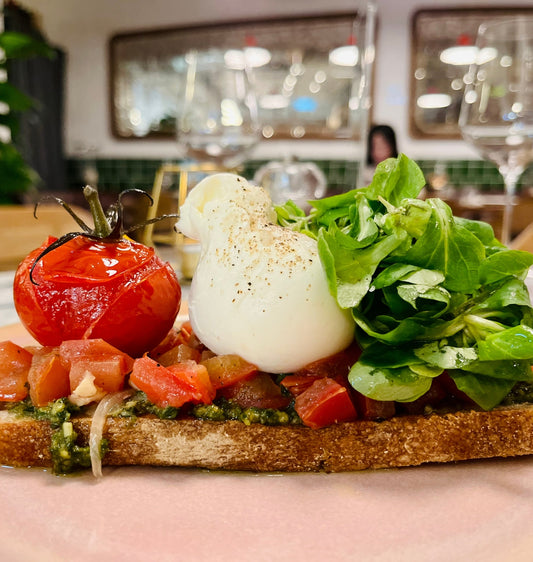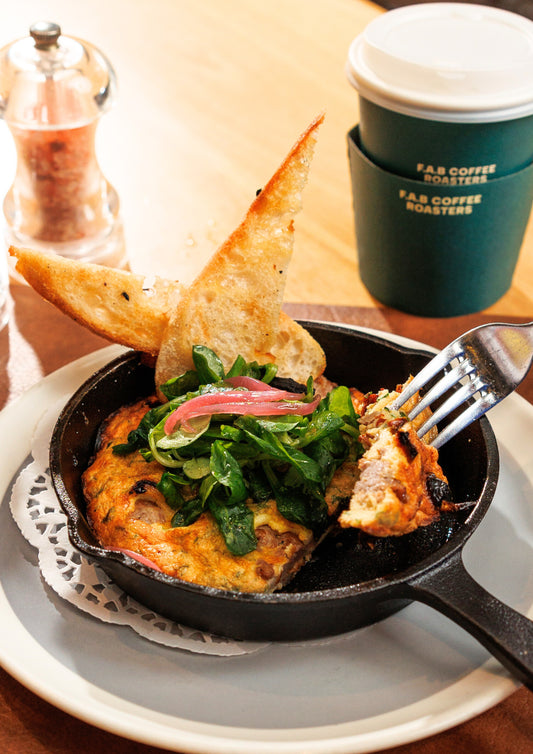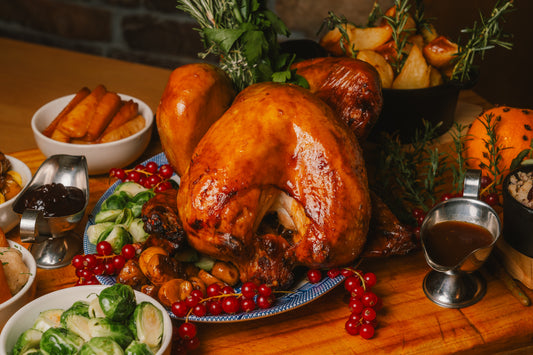
Rack of Lamb Recipe
For a succulent, juicy roast rack of lamb, start with the very best ingredients from Feather & Bone then follow our chef's detailed steps for guaranteed success.
If your mission is to dial up the ‘wow factor’ whilst keeping effort to a minimum, you have to be roasting. Season or marinate a large piece of meat, whack it in the oven, then join your dinner guests for a drink as the joint slowly cooks away to roasted perfection. There are hardly any variables here, so get a few things right and you’ll be guaranteed success. If you start with a primo piece of meat and cook it for the right amount of time at the correct temperature, you simply can’t go wrong. Of course, our recipes will spell out all the nitty-gritty for you.
Delicate, tender lamb cutlets should not be served beyond medium-rare. As a low working cut, there is minimal connective tissue or strong fibrous muscles that need time to break down, so a short cooking time is ideal. A quick sear in a hot pan is required, meaning on high heat, ideally in a heavy-bottomed pan starting with the fat side (always remember to ask your butcher to leave a little fat on), then rotating onto all sides to form a beautiful brown crust. This followed by 15 minutes in the oven at 180°C (make sure the oven is preheated) is sufficient for succulent and juicy meat - they will slice apart into perfect cutlets ready to serve.
You can learn all about the different cuts of lamb and the butchering process in our Lamb Breakdown Masterclass.
Whilst we’re on the subject of browning, let us food nerds tell you a little something about The Maillard reaction. This is a bit of culinary chemistry where strong, direct heat caramelises natural sugars in meat, creating toasty and savoury characters for the ultimate meat experience. Whether you’re searing a steak on a griddle pan or BBQ, browning stewing cuts before their long braise, or in this case - building a ‘crust’ on a joint before it roasts in the oven, it’s something worth putting a little extra effort into.
So, the perfect roast rack of lamb is achieved in four stages. Marinating, searing, roasting and resting. Now let us meat-head (we mean, meat-minded) chefs walk you through the process for a fool-proof roast dinner.
Rack of Lamb - The Recipe
Ingredients
2 700g racks of lamb – frenched, fat cap on
4 cloves of garlic – minced
Half a pack (10g) of rosemary – leaves picked and finely chopped
60ml extra virgin olive oil – for marinade
40ml olive oil – for searing
A 4-finger pinch of sea salt flakes
Black pepper to taste
Method
Prepare the marinade
To make the marinade, mix the garlic, rosemary, salt, pepper and extra virgin olive oil. Have a taste - it should be quite garlicky, but not overwhelming, very salty with pronounced herbaceous notes from the rosemary. Add salt, pepper or olive oil if needed. Remember, the marinade should be powerful as it will be diluted over the two lamb racks.
If there’s fat left on the meat, with a sharp knife or Stanley knife, cut a criss-cross pattern with diagonal lines about 1cm apart. Make sure you only cut into the fat, not the meat.
Rub the marinade into the racks, make sure every side of the meat is coated, don’t worry about the bones; just leave them sticking out.
Marinate in the fridge
Place the lamb into zip lock bags and squeeze out all of the extra air - this will help the marinade stick to the meat, then refrigerate. Anywhere from 2 hours up to 2 days is fine, the longer you leave it, the more flavour the marinade will impart.
Bring to room temperature
Two hours before dinner take the lamb out of the fridge, because it needs to come all the way to room temperature. This is a crucial step. If the centre of the meat is still fridge-cold when it goes into the oven, it won’t have time to cook properly, leaving you with a couple of underdone cutlets in the middle, or overdone ones on the ends.
Preheat the oven and roast
Stand the racks so that the fat / bone side is facing up (you can intertwine the two racks to make them stand nicely), so that the fat at the top melts into the meat as it cooks, keeping it moister and adding more flavour.
Preheat the oven to 180°C. 30 minutes before dinner, roast the racks for 15 minutes, then insert a meat thermometer deep into the middle of one of the racks - the temperature should be around 57°C. If it is below that, put them back in for another 5 minutes or so then re-test.
Leave to rest
Remove the racks from the oven, cover them loosely with foil (this is called ‘tenting’, make a little foil tent), and leave them to rest for 10 minutes.
Bring the racks to the table with a sharp carving knife. Accept your round of applause graciously, then slice into individual cutlets to serve.



